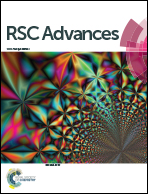Decoration of Fe3O4 magnetic nanoparticles on graphene oxide nanosheets
Abstract
This study focuses on covalent grafting of Fe3O4 magnetic nanoparticles (MNPs) to graphene oxide nanosheets (GNOS) via three different chemical routes. To this purpose, firstly, dopamine-functionalized Fe3O4 (Fe3O4/DA) nanoparticles were firmly attached onto the surface of GONS by activation of carboxylic groups of GONS via thionyl chloride (SOCl2), anhydride formation by using trifluoro acetic acid (TFAA) and 1-ethyl-3-(3-dimethylaminopropyl)carbodiimide/N-hydroxysuccinimide (EDC/NHS) to form Fe3O4/DA/GONS. The attachment of Fe3O4 MNPs on the GONS surface was evaluated and compared by using FT-IR, XRD, TEM, TGA, VSM, TEM and SAED techniques. The results showed that, depending on the route used, the density and immobilization site of Fe3O4 MNPs can be different.


 Please wait while we load your content...
Please wait while we load your content...